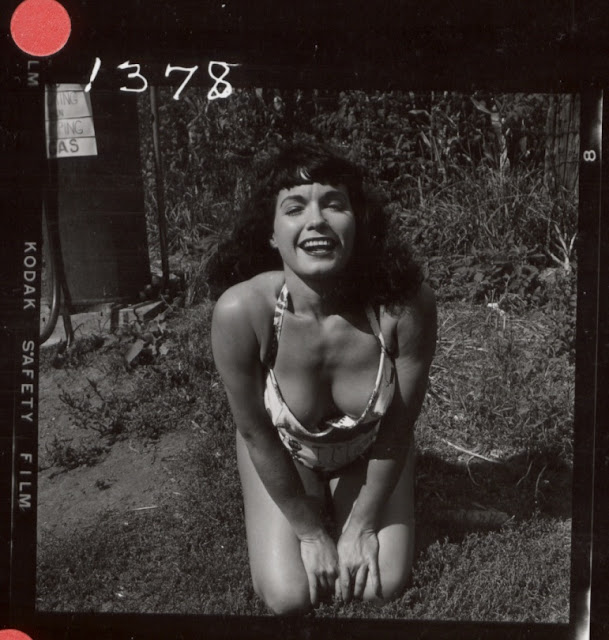In the fall of 1950, Bettie Page was simply working as a secretary living in Midtown Manhattan, with dreams of a more fascinating life. It just so happened that during a solitary walk along the beach at Coney Island, she was approached by Jerry Tibbs, a police officer with a hobby of photographing models. The two hit it off instantly and Bettie Page soon posed for her first pinup shots.
Not long after Bettie Page met Tibbs was she introduced to Cass Carr, a Jamaican musician with a passion for photography who ran a number of camera clubs in New York City and New Jersey. This opportunity gave Bettie Page the chance to explore the possibilities of a new style of modeling almost unheard of at the time.
The conservative era of the 1940s and 1950s in America made it rather difficult for artists to fully express themselves in the world of erotic art. One avenue, which made it possible for artists and models alike to explore this territory, was camera clubs. These underground clubs allowed people to engage in activities that would otherwise be considered taboo and or pose a threat towards society. Bettie Page used camera clubs as a means of self-expression and self-exploration.
In the beginning of the camera club days, Bettie Page started off as a glamour model. This meant she would often pose half nude to fully nude for photo shoots. Her lack of inhibition in these shots gave Bettie Page her own style. This approach to modeling drew the attention of fans and brought her to the top of the camera club industry. Shortly after, she began posing for photographs which included themes of sadomasochism and bondage. This would later make her the first famous bondage model.
The raw look and irony of the camera club photos still make an impression on viewers today. Many are thrown off because they’re not used to seeing photos of this type of behavior, especially in Grandma’s living room on her gorgeous, green, upholstered mid-century couch. Prior to viewing the shots, some may not have been aware that this type of behavior even existed in the 1950s. The shots give you an eye-opening view of the subculture that existed during this time period. This could be why they remain so popular today.
Many consider leaders of underground movements, such as Bettie Page, to be the real innovators of their time. It takes someone of true bravery to express oneself in this nature. Bettie Page pushed the limits of what was accepted in society by embracing camera clubs and pushing for what she believed in. Her dynamic beauty and free spirit led her to innovation and uprooting the buried sexuality of our time.
[via BettiePage.com]
Famous crime/street photographer Weegee gets a closer look.
Film based on Bettie Page:
Not long after Bettie Page met Tibbs was she introduced to Cass Carr, a Jamaican musician with a passion for photography who ran a number of camera clubs in New York City and New Jersey. This opportunity gave Bettie Page the chance to explore the possibilities of a new style of modeling almost unheard of at the time.
The conservative era of the 1940s and 1950s in America made it rather difficult for artists to fully express themselves in the world of erotic art. One avenue, which made it possible for artists and models alike to explore this territory, was camera clubs. These underground clubs allowed people to engage in activities that would otherwise be considered taboo and or pose a threat towards society. Bettie Page used camera clubs as a means of self-expression and self-exploration.
In the beginning of the camera club days, Bettie Page started off as a glamour model. This meant she would often pose half nude to fully nude for photo shoots. Her lack of inhibition in these shots gave Bettie Page her own style. This approach to modeling drew the attention of fans and brought her to the top of the camera club industry. Shortly after, she began posing for photographs which included themes of sadomasochism and bondage. This would later make her the first famous bondage model.
The raw look and irony of the camera club photos still make an impression on viewers today. Many are thrown off because they’re not used to seeing photos of this type of behavior, especially in Grandma’s living room on her gorgeous, green, upholstered mid-century couch. Prior to viewing the shots, some may not have been aware that this type of behavior even existed in the 1950s. The shots give you an eye-opening view of the subculture that existed during this time period. This could be why they remain so popular today.
Many consider leaders of underground movements, such as Bettie Page, to be the real innovators of their time. It takes someone of true bravery to express oneself in this nature. Bettie Page pushed the limits of what was accepted in society by embracing camera clubs and pushing for what she believed in. Her dynamic beauty and free spirit led her to innovation and uprooting the buried sexuality of our time.
[via BettiePage.com]
Famous crime/street photographer Weegee gets a closer look.
Film based on Bettie Page:
You have read this article Bettie Page /
camera clubs
with the title 50's Pin Up Model Bettie Page and the Camera Clubs. You can bookmark this page URL http://nikiinwonderland.blogspot.com/2012/03/50-pin-up-model-bettie-page-and-camera.html. Thanks!

























